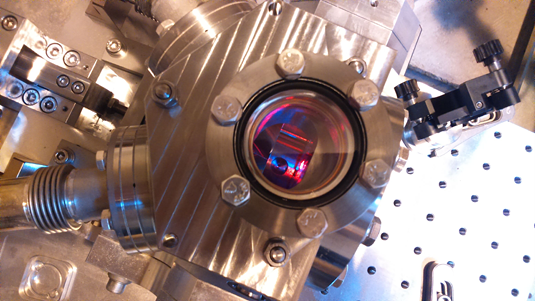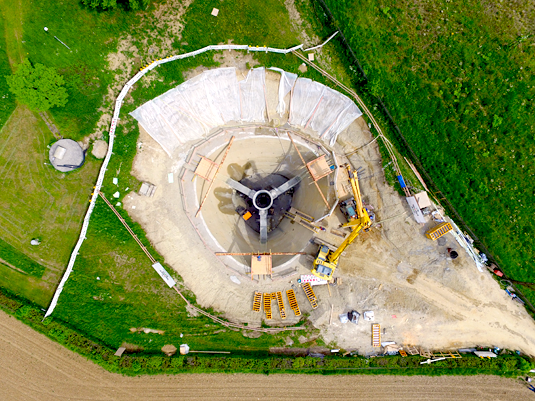Running light around a tetrahedron

Thanks to an innovative ring laser design, geophysicists at LMU can now measure and monitor Earth's rotation with unprecedented accuracy. The new instrument in Fürstenfeldbruck will be formally inaugurated this week.
The world has so far taken relatively little notice of Fürstenfeldbruck, a town located about 20 km from Munich. It certainly doesn't rate as a hotspot for cutting-edge science. But that is about to change. For geophysicists based at LMU and the Technical University of Munich (TUM) have built an instrument there which sets a new standard in its field. Buried in an underground bunker built amid cropland and open fields, the device takes up several hundred cubic meters of space. Its purpose is to measure rotational ground motions with greater sensitivity and precision than any other machine in existence.
Even the editors of the leading research journal Science are clearly impressed by the dimensions – and the capabilities – of the new instrument. In a news feature that appeared in a recent issue of the magazine, the novel ring laser is referred to as the "most sophisticated" instrument of its kind in the world. The leader of the ROMY (Rotational Motions in Seismology) project is Heiner Igel, Professor of Seismology at LMU. The concept won him one of the richly endowed Advanced Investigator Grants awarded by the European Research Council (ERC), and the LMU went on to supply the additional funding required for its final realization. The initial tests and experiments have been successful, and the instrument will be officially put into service this week.
Our restless planet
Ring lasers are exquisitely sensitive to rotational motion. They can, for example, measure the Earth's rotation with extremely high precision. Our planet is never at rest, rotating on its own axis every day and orbiting the Sun once a year. But it doesn't follow exactly the same course year for year. Its trajectory is subject to minimal deviations. In fact, it behaves just like a child's spinning top: Neither the orientation of its axis nor the speed of its rotation is constant. It is buffeted by strong winds in the upper atmosphere and by ocean currents at depth, and massive earthquakes knock it out of kilter. But then, the Earth itself is anything but a perfect sphere. No wonder it fails to follow the ideal of perfect circular motion that Aristotle once prescribed for it.
Moreover, quantifying the minimal variations in the many different components of the Earth's motions is not solely a matter of academic interest. For example, all GPS-based navigational systems must be periodically recalibrated in order to take account of these variations, which would otherwise give rise to significant errors in determining one's position on the globe. This task is currently done with the aid of Very Long Baseline Interferometry (VLBI), which uses a network of radio telescopes to determine the distances between the Earth and selected quasars in deep space that are millions of light-years from us. But this method is complicated and it takes days to arrive at the final result. The Munich researchers believe that their new ring laser will enable them to achieve at least the same accuracy in far less time. If they are right, results could be updated within seconds rather than days.
But this is only a small part of Heiner Igel's vision for the new high-end instrument. – He intends to open up a whole new dimension in seismology by using it to carry out more detailed analyses of seismically induced ground motions. For when an earthquake occurs, the ground not only shakes up and down, and back and forth. Tremors are also characterized by tilting and rotational motions around a fixed point. So far, seismologists have had to ignore such motions, simply because conventional seismometers provide no means of measuring them. However, Igel believes – contrary to received wisdom – that a realistic and complete picture of ground motions during earthquakes requires the acquisition and integration of this information.
Indeed, he and his colleagues hope that the new ring laser will provide answers to a whole series of open questions. For instance, rotation sensors can measure the magnitude of tilting and rotational ground motions, which structural engineers need to enhance the stability of buildings in earthquake zones. Rotation sensors can also provide data that give insights into anomalous magma dynamics in active volcanoes, and thus serve to improve the quality of corresponding modeling studies. In combination with other methods, such measurements permit geophysicists to probe the properties and the dynamics of the Earth's interior, Igel explains. And that's not all. ROMY also promises to shed new light on how the world's oceans interact physically with the planet, causing it to oscillate permanently.
The principle on which the instrument's operation is based was first demonstrated by the French physicist Georges Sagnac shortly before the outbreak of the First World War: He showed a beam of light is directed around a closed course (with the aid of mirrors), the time it takes to complete a circuit is independent of the direction in which it propagates. However, if the apparatus is rotated, the beam travelling in the same sense as the rotation takes slightly longer for each lap – because it has to cover a greater distance than a beam transmitted in the opposite direction. Due to this difference in path-length, two counter-propagating beams will be phase shifted with respect to one another and, when recombined, they produce a typical interference pattern. In exactly the same way, when two notes that are slightly out of tune are sounded together, they produce a characteristic beat note which varies regularly in pitch. Moreover, the rotation rate can be calculated from the frequency of the beat note produced when the counter-propagating beams are superimposed.
Igel and laser physicist Ulrich Schreiber from the TUM made use of this principle in their design for ROMY to measure spin or tilting motions. In this case, the laser beams are propagated along not one but four axes. Each of the four light paths forms the edges of an equilateral triangle with sides 12 m long, At each apex, the light is deflected by mirrors, whose positions can be adjusted with high precision. Together, the four rings form the faces of a regular, inverted tetrahedron whose apex lies 15 m underground. This set-up enables the scientists to measure rotational motions in all directions.

Five km of optic fiber, tightly wound
"It took us two years to work out how to build it," Igel says. To ensure high sensitivity, the ring lasers must be shielded from environmental interference. For example, in order to protect the instrument from ground water, it was enclosed in a tetrahedral concrete shell – like a plant in a flower pot. Igel realized early on that he needed to have his colleague from the TUM onboard to make the project a success – for Schreiber had already designed and built several ring-laser systems in Germany, New Zealand, the USA, Italy and elsewhere. ROMY, however, is undoubtedly his masterpiece. Incorporating computer-controlled precision engineering into an instrument with dimensions of 12 m requires a new level of meticulousness.
Meanwhile, the instrument has not only been tested and calibrated, it has already performed a whole series of measurements which will form the basis for several publications. For example, some of the aftershocks observed after the series of earthquakes in Norcia in Central Italy in October 2016 have been characterized, as well as the seismic noise generated by the Earth's oceans.
Recording the hitherto unquantifiable tilt and rotational motions in the field, i.e. in the vicinity of the seismic focus of an earthquake, will require the use of portable instruments, Igel says – and the researchers responsible for ROMY have already taken a major step towards this goal. They have teamed up with a specialist company in France to develop a portable fibre-optic-based sensor, and the first prototypes were on show at a large geosciences conference held in Vienna in April. These instruments use an extremely thin optic fiber of 5 km in length, which is coiled onto a spool: "A real milestone," Igel enthuses. The initial measurements performed in Central Italy, and on the volcanic island of Stromboli off the north coast of Sicily "look good," he says.
The pioneers in Munich hope that others will follow the example set by ROMY. If so, we should someday have a global network of ring-laser seismometers which can finally provide us with a truly comprehensive picture of the dynamics of the Earth's motions. In such a network, Fürstenfeldbruck's ring would serve as an essential node – a hotspot, so to speak.
Journal information: Science
Provided by Ludwig Maximilian University of Munich

















